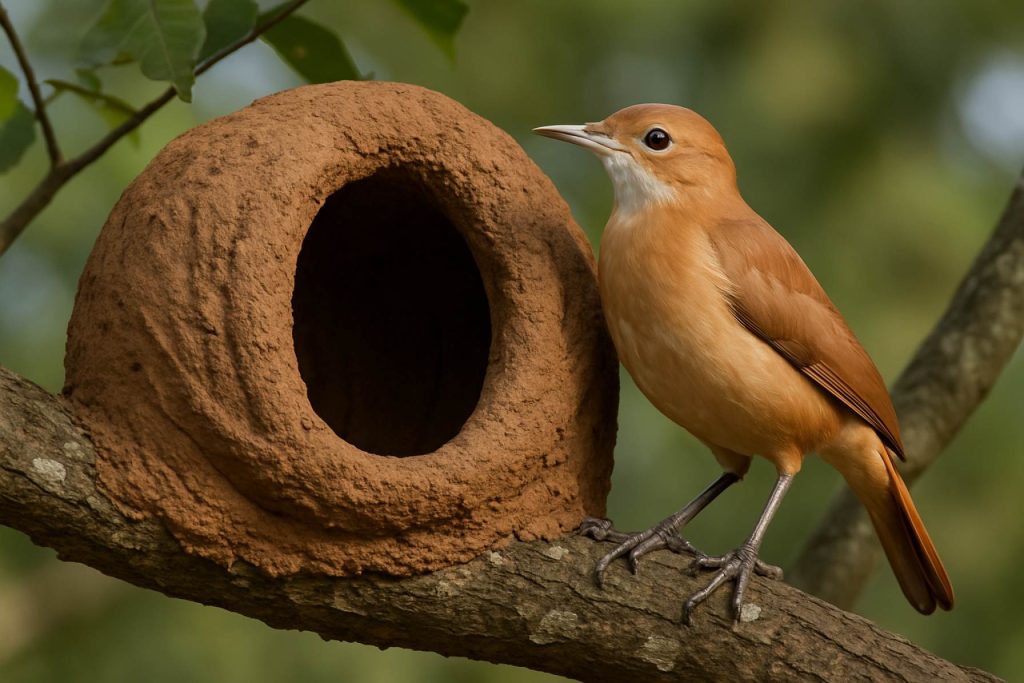
Inside the Ingenious World of Joao-de-barro (Furnarius rufus): How South America’s Clay-Building Bird Redefines Avian Engineering and Survival
- Introduction to Joao-de-barro: Species Overview
- Taxonomy and Evolutionary Background
- Geographic Distribution and Preferred Habitats
- Unique Nest Architecture: Design and Construction
- Breeding Behavior and Reproductive Strategies
- Diet, Foraging, and Ecological Role
- Vocalizations and Communication Patterns
- Interactions with Humans and Cultural Significance
- Conservation Status and Environmental Threats
- Future Research Directions and Unanswered Questions
- Sources & References
Introduction to Joao-de-barro: Species Overview
The Joao-de-barro (Furnarius rufus), also known as the Rufous Hornero, is a passerine bird native to South America, particularly widespread in countries such as Brazil, Argentina, Uruguay, Paraguay, and Bolivia. Belonging to the Furnariidae family, this species is renowned for its distinctive nesting behavior and remarkable adaptability to diverse habitats, ranging from open woodlands and savannas to urban parks and gardens. The Joao-de-barro is easily recognized by its rufous-brown plumage, upright posture, and robust build, typically measuring about 18 to 20 centimeters in length.
One of the most notable characteristics of the Joao-de-barro is its unique nest construction. The species is famous for building oven-shaped nests out of mud and straw, which harden to form a durable structure resembling a traditional clay oven. These nests are often found on fence posts, tree branches, or even on man-made structures, demonstrating the bird’s remarkable ability to thrive in both natural and human-altered environments. The construction process is a cooperative effort between the male and female, and the resulting nest provides protection from predators and harsh weather conditions.
The Joao-de-barro plays a significant ecological role in its native range. As an insectivore, it helps control populations of various invertebrates, contributing to the balance of local ecosystems. Its adaptability and resilience have made it a common sight across much of its range, and it is not currently considered threatened. In Brazil, the Joao-de-barro holds cultural importance and is celebrated as a symbol of hard work and ingenuity, even being designated as the national bird in some regions.
Taxonomically, the Joao-de-barro is classified within the order Passeriformes, which encompasses more than half of all bird species worldwide. The Furnariidae family, to which it belongs, is a diverse group of Neotropical birds known for their elaborate nest-building behaviors. The scientific study and conservation of the Joao-de-barro and its relatives are supported by ornithological organizations and research institutions throughout South America, including national environmental agencies and academic bodies such as the Instituto Brasileiro do Meio Ambiente e dos Recursos Naturais Renováveis (IBAMA), which oversees wildlife protection and biodiversity in Brazil.
Taxonomy and Evolutionary Background
The Joao-de-barro (Furnarius rufus), also known as the Rufous Hornero, is a passerine bird belonging to the family Furnariidae, a diverse group commonly referred to as ovenbirds due to their distinctive nest-building behavior. The Furnariidae family is part of the order Passeriformes, which encompasses more than half of all bird species worldwide. Within Furnariidae, the genus Furnarius includes several species, but F. rufus is among the most widely recognized, particularly in South America.
The taxonomic classification of the Joao-de-barro is as follows:
- Kingdom: Animalia
- Phylum: Chordata
- Class: Aves
- Order: Passeriformes
- Family: Furnariidae
- Genus: Furnarius
- Species: Furnarius rufus
The evolutionary history of the Furnariidae family is notable for its adaptive radiation throughout Central and South America. Molecular phylogenetic studies suggest that the family diverged from other passerines during the Miocene epoch, approximately 15–20 million years ago. The genus Furnarius is characterized by its members’ unique adaptation of constructing oven-shaped mud nests, a trait that has contributed to their ecological success and wide distribution across open and semi-open habitats in South America.
The Joao-de-barro’s evolutionary lineage is closely tied to the development of its nesting behavior, which is considered a key innovation within the Furnariidae. This behavior not only provides protection from predators and environmental extremes but also plays a role in mate selection and territoriality. The species’ range extends across Brazil, Argentina, Uruguay, Paraguay, and Bolivia, reflecting its adaptability to diverse environments, from grasslands to urban areas.
The International Union for Conservation of Nature (IUCN) currently lists the Joao-de-barro as a species of Least Concern, indicating stable populations throughout its range. The evolutionary success of Furnarius rufus is attributed to its behavioral flexibility, broad diet, and ability to thrive in human-modified landscapes. Ongoing research by ornithological organizations, such as BirdLife International, continues to shed light on the evolutionary relationships within the Furnariidae and the ecological significance of the Joao-de-barro in South American avifauna.
Geographic Distribution and Preferred Habitats
The Joao-de-barro (Furnarius rufus), also known as the Rufous Hornero, is a passerine bird native to South America. Its geographic distribution is extensive, spanning several countries in the continent. The species is most commonly found in Brazil, where it is widely recognized and even celebrated as a national symbol. Beyond Brazil, the Joao-de-barro inhabits eastern and southern Bolivia, Paraguay, Uruguay, northern and central Argentina, and parts of southeastern Peru. This broad range reflects the bird’s adaptability to diverse environmental conditions.
Within its range, the Joao-de-barro demonstrates a preference for open and semi-open habitats. It thrives in savannas, grasslands, pastures, agricultural fields, and the edges of forests. The species is also frequently observed in rural and suburban areas, where human activity has created suitable open spaces. Unlike many forest-dependent birds, the Joao-de-barro avoids dense, closed-canopy forests, instead favoring landscapes with scattered trees or shrubs that provide suitable sites for its distinctive mud nests.
The bird’s adaptability to human-modified environments is notable. It often builds its nests on fence posts, utility poles, and the walls of buildings, taking advantage of the structural support these features provide. This behavior has facilitated the Joao-de-barro’s persistence and even expansion in areas where natural habitats have been altered or fragmented by agriculture and urbanization. Its presence in both pristine and disturbed habitats underscores its ecological flexibility.
Elevation-wise, the Joao-de-barro is typically found from sea level up to about 2,000 meters, although it is most abundant in lowland and foothill regions. The availability of mud and clay for nest construction is a key factor influencing its local distribution, as these materials are essential for building the species’ characteristic oven-shaped nests.
The Joao-de-barro’s widespread distribution and habitat preferences have made it a familiar and iconic species across much of South America. Its adaptability to a range of environments, including those shaped by human activity, has contributed to its stable population status and cultural prominence in the region.
Unique Nest Architecture: Design and Construction
The Joao-de-barro (Furnarius rufus), also known as the Rufous Hornero, is renowned for its distinctive nest architecture, which stands out among Neotropical birds. This species constructs oven-shaped nests from mud and organic material, a behavior that has inspired its common name—“ovenbird.” The nest is typically built on horizontal branches, fence posts, or even man-made structures, demonstrating the bird’s adaptability to diverse environments.
The construction process is a remarkable example of avian engineering. Both male and female Joao-de-barro participate in building the nest, which can take several weeks to complete. They gather mud, straw, and dung, mixing these materials to form a malleable paste. Using their beaks, they meticulously shape the nest, layer by layer, until it reaches its characteristic domed form. The finished structure is roughly spherical, with a side entrance leading to a winding internal passage that opens into a nesting chamber. This design serves multiple functions: it protects the eggs and chicks from predators, insulates against temperature extremes, and shields the interior from rain and wind.
The nest’s architecture is not only functional but also highly durable. Once dried, the mud hardens into a robust shell that can last for several years, often outliving the original occupants. Abandoned nests are frequently reused by other bird species, small mammals, or insects, highlighting their ecological significance. The orientation of the nest entrance is also thought to be strategic; studies suggest that Joao-de-barro may position the entrance away from prevailing winds or intense sunlight, further enhancing the nest’s protective qualities.
The unique nest-building behavior of the Joao-de-barro has attracted the attention of ornithologists and naturalists for centuries. It is often cited as a prime example of instinctive animal architecture and has become a cultural symbol in several South American countries, particularly Brazil and Argentina. The species is recognized and monitored by organizations such as International Union for Conservation of Nature (IUCN) and is featured in regional conservation programs due to its ecological importance and iconic status.
In summary, the Joao-de-barro’s nest is a marvel of natural engineering, combining practical design, environmental adaptation, and cultural significance. Its construction process and enduring structure exemplify the ingenuity found in avian architecture.
Breeding Behavior and Reproductive Strategies
The Joao-de-barro (Furnarius rufus), a member of the ovenbird family, is renowned for its distinctive breeding behavior and reproductive strategies, which are closely tied to its unique nest-building practices. This species is native to South America, particularly widespread in Brazil, Argentina, Uruguay, Paraguay, and Bolivia. The breeding season typically coincides with the austral spring and summer, from August to December, when environmental conditions are most favorable for raising offspring.
A hallmark of the Joao-de-barro’s reproductive strategy is its monogamous pair bonding. Pairs often remain together for multiple breeding seasons, collaborating closely in all aspects of reproduction. Courtship involves mutual displays and vocalizations, strengthening the pair bond and synchronizing reproductive readiness. Once paired, both male and female participate in the construction of their iconic oven-shaped mud nests, which are usually built on tree branches, fence posts, or even man-made structures. The nest, composed of mud and organic material, is meticulously crafted over several weeks and serves as both a breeding site and a protective barrier against predators and environmental extremes.
After nest completion, the female typically lays two to four eggs. Both parents share incubation duties, which last approximately 14 to 18 days. This biparental care extends to feeding and protecting the chicks after hatching. The nest’s design, with its chambered structure and narrow entrance, helps regulate temperature and humidity, providing a stable microclimate for egg and chick development. The chicks are altricial at birth, requiring extensive parental care, and fledge about 23 to 26 days after hatching.
Joao-de-barro pairs may reuse or refurbish old nests for subsequent breeding attempts, or construct new ones each season, sometimes even building multiple nests before selecting one for egg-laying. This behavior may serve as a strategy to deter parasites and predators, as well as to demonstrate fitness to potential mates. The species’ reproductive success is closely linked to the availability of suitable nesting sites and the integrity of their mud nests, which are vulnerable to heavy rainfall and human disturbance.
The breeding behavior and reproductive strategies of the Joao-de-barro exemplify the complex interplay between environmental adaptation, social cooperation, and architectural ingenuity. These traits have made the species a subject of interest for ornithologists and conservationists, as well as a cultural symbol in its native range. For further information on avian breeding strategies and the biology of ovenbirds, consult resources from the Cornell University and the BirdLife International.
Diet, Foraging, and Ecological Role
The Joao-de-barro (Furnarius rufus), a member of the ovenbird family (Furnariidae), is renowned not only for its unique mud nests but also for its adaptive diet and significant ecological role in South American ecosystems. This species is primarily insectivorous, feeding on a wide variety of arthropods such as beetles, ants, termites, spiders, and caterpillars. Its foraging behavior is typically terrestrial; the Joao-de-barro is often observed walking or hopping on the ground, probing leaf litter, soil, and under stones with its slightly curved bill to extract prey. Occasionally, it supplements its diet with seeds and small fruits, especially during periods when insect abundance is low.
Foraging activity is most intense during the early morning and late afternoon, coinciding with peak invertebrate activity. The Joao-de-barro’s methodical search for food helps control populations of soil-dwelling insects and other invertebrates, contributing to the balance of local food webs. Its adaptability allows it to thrive in a range of habitats, from open woodlands and savannas to agricultural fields and urban parks, demonstrating ecological flexibility.
Ecologically, the Joao-de-barro plays a dual role. As a predator, it regulates insect populations, which can benefit agriculture by reducing pest species. As a prey species, it provides food for a variety of predators, including birds of prey, snakes, and small mammals. Furthermore, its distinctive mud nests, which are constructed on tree branches, fence posts, or even man-made structures, offer secondary nesting sites for other bird species and small animals once abandoned. This nesting behavior enhances local biodiversity by providing shelter in otherwise exposed environments.
The Joao-de-barro’s foraging and nesting activities also influence soil structure and nutrient cycling. By disturbing leaf litter and soil during feeding, it aids in decomposition processes and the aeration of the ground. Its presence is often considered an indicator of healthy, biodiverse habitats. Conservation organizations and ornithological authorities, such as BirdLife International, recognize the Joao-de-barro as a species of Least Concern, reflecting its stable populations and broad ecological adaptability.
In summary, the Joao-de-barro’s diet and foraging strategies are closely linked to its ecological role as both a regulator of invertebrate populations and a facilitator of habitat complexity, underscoring its importance in the ecosystems it inhabits.
Vocalizations and Communication Patterns
The Joao-de-barro (Furnarius rufus), a member of the Furnariidae family, is renowned not only for its distinctive oven-shaped mud nests but also for its complex vocalizations and communication patterns. Vocal communication plays a central role in the daily life of this species, facilitating territory defense, mate attraction, and pair bonding. The Joao-de-barro’s song is characterized by a series of melodious, whistled notes, often delivered in duets by mated pairs. These duets are highly synchronized, with each bird contributing alternating phrases, creating a seamless and harmonious sequence that is both species-specific and individually distinctive.
Research indicates that these vocal duets serve multiple functions. Primarily, they reinforce the pair bond between mates, a crucial aspect given the species’ monogamous and cooperative nesting behavior. Additionally, the duets act as a territorial signal, warning neighboring pairs of the presence and unity of the resident pair. This is particularly important in the open habitats favored by the Joao-de-barro, where visual barriers are minimal and acoustic signals can travel long distances. The complexity and coordination of the duets are thought to be honest indicators of pair stability and reproductive fitness.
Beyond duetting, Joao-de-barro individuals employ a repertoire of calls for various social interactions. Alarm calls are used to alert mates and offspring to potential threats, while softer contact calls help maintain cohesion between partners during foraging or nest-building activities. Juveniles also produce distinct begging calls to solicit food from parents. The species’ vocalizations are adapted to their environment, with frequencies and patterns that minimize interference from ambient noise and maximize transmission through open landscapes.
Studies of the Joao-de-barro’s vocal behavior contribute to broader ornithological understanding of duet singing and its evolutionary significance among suboscine passerines. The species’ communication patterns have been documented in detail by ornithologists and are recognized as a model for studying the interplay between social structure and vocal complexity in birds. Organizations such as BirdLife International and the Cornell University Ornithology Lab provide resources and research on the acoustic ecology of Neotropical birds, including the Joao-de-barro.
Interactions with Humans and Cultural Significance
The Joao-de-barro (Furnarius rufus), also known as the Rufous Hornero, holds a unique place in the cultural and social landscape of South America, particularly in countries such as Brazil, Argentina, Uruguay, and Paraguay. Its distinctive oven-shaped mud nests, often built on fence posts, utility poles, and the edges of rural houses, have made it a familiar and endearing presence in both urban and rural environments. These nests are not only architectural marvels but also serve as symbols of industriousness and domestic harmony in local folklore.
In Brazil, the Joao-de-barro is celebrated as a symbol of hard work and family unity. Its name, which translates to “John of clay,” reflects the bird’s remarkable nest-building skills. The species is frequently referenced in literature, music, and visual arts, embodying values such as perseverance and cooperation. For example, the bird’s nesting behavior—where both male and female collaborate to construct their home—has inspired numerous proverbs and children’s stories emphasizing the importance of partnership and diligence.
The Joao-de-barro’s relationship with humans is generally positive. Its presence is often welcomed, as the bird is not considered a pest and its nests are believed to bring good luck or protection to households. In some rural areas, people avoid disturbing the nests, respecting the bird’s role as a harbinger of harmony and prosperity. The species’ adaptability to human-modified landscapes has further strengthened its bond with local communities, making it a common sight in gardens, parks, and agricultural fields.
Beyond folklore, the Joao-de-barro has also been recognized in official contexts. It is the national bird of Argentina, a status that underscores its importance in the country’s natural heritage and identity. Conservation organizations and governmental agencies in South America, such as the Instituto Brasileiro do Meio Ambiente e dos Recursos Naturais Renováveis (IBAMA), acknowledge the species as a key component of regional biodiversity and promote its protection through environmental education initiatives.
In summary, the Joao-de-barro’s interactions with humans are characterized by mutual respect and cultural reverence. Its industrious nature, architectural prowess, and adaptability have made it a beloved figure, deeply woven into the social and symbolic fabric of South American societies.
Conservation Status and Environmental Threats
The Joao-de-barro (Furnarius rufus), also known as the Rufous Hornero, is a passerine bird native to South America, particularly widespread in Brazil, Argentina, Uruguay, Paraguay, and Bolivia. According to the International Union for Conservation of Nature (IUCN), the species is currently classified as “Least Concern” on the IUCN Red List. This status reflects its broad distribution, large population size, and adaptability to a variety of habitats, including open woodlands, savannas, agricultural areas, and even urban environments.
Despite its stable conservation status, the Joao-de-barro faces several environmental threats that could impact its populations in the future. Habitat loss due to agricultural expansion, urbanization, and deforestation remains a significant concern across much of its range. The conversion of native habitats into farmland or urban areas can reduce the availability of suitable nesting sites and foraging grounds. However, the species’ remarkable adaptability allows it to thrive in modified landscapes, often building its distinctive mud nests on man-made structures such as fence posts, utility poles, and buildings.
Another potential threat is the use of pesticides and other agrochemicals in intensive farming regions. These substances can reduce insect populations, which are a primary food source for the Joao-de-barro, and may also pose direct toxicological risks to the birds themselves. Climate change is an emerging concern, as alterations in rainfall patterns and temperature could affect the availability of mud for nest construction and influence the distribution of suitable habitats.
Conservation efforts for the Joao-de-barro are currently limited, given its stable population and adaptability. However, ongoing monitoring by organizations such as IUCN and national environmental agencies is essential to detect any future declines or emerging threats. Maintaining native vegetation, promoting sustainable agricultural practices, and minimizing the use of harmful chemicals can help safeguard the species and its habitat. The Joao-de-barro also benefits from legal protection in several countries within its range, further supporting its continued survival.
In summary, while the Joao-de-barro is not presently at risk of extinction, continued vigilance is necessary to ensure that environmental changes and human activities do not negatively impact this iconic South American bird in the future.
Future Research Directions and Unanswered Questions
Despite extensive research on the Joao-de-barro (Furnarius rufus), several intriguing questions remain, and future research directions promise to deepen our understanding of this iconic South American bird. One key area for future study is the species’ remarkable nest-building behavior. While the basic structure and function of the mud nests are well documented, the precise cognitive and environmental factors influencing nest architecture, site selection, and construction timing are not fully understood. Investigating the genetic and neurological underpinnings of these behaviors could provide insights into avian cognition and the evolution of complex construction skills.
Another promising research direction involves the ecological impact of Joao-de-barro nests on local biodiversity. Their nests are often reused by other bird species and small animals, suggesting a potential role as ecosystem engineers. Quantifying these interactions and their effects on community dynamics could reveal broader ecological significance, contributing to conservation strategies in South American grasslands and savannas.
Climate change presents additional unanswered questions. The Joao-de-barro’s reliance on mud for nest construction makes it potentially vulnerable to shifts in rainfall patterns and soil composition. Long-term monitoring of nesting success and population trends in relation to changing climate variables would help assess the species’ resilience and inform adaptive management approaches. Furthermore, understanding how urbanization and habitat fragmentation affect their distribution and reproductive success remains a critical area for research, especially as human development expands across their range.
Genetic studies of population structure and gene flow across the Joao-de-barro’s wide distribution could clarify how isolated populations adapt to local conditions. Such research may also uncover cryptic diversity within the species, with implications for taxonomy and conservation. Additionally, the role of vocalizations in mate selection and territory defense, while described, warrants further experimental investigation to elucidate the mechanisms of communication and social organization.
Finally, collaborative efforts between ornithologists, ecologists, and conservation organizations—such as those coordinated by the BirdLife International partnership—will be essential for addressing these questions. By integrating field studies, citizen science, and advanced technologies like bioacoustics and remote sensing, future research can provide a more comprehensive understanding of the Joao-de-barro’s biology and its role in South American ecosystems.



